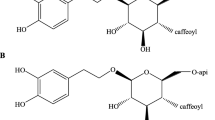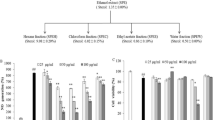Abstract
Background
Boswellia serrate is an ancient and highly valued ayurvedic herb. Its extracts have been used in medicine for centuries to treat a wide variety of chronic inflammatory diseases. However, the mechanism by which B. serrata hydro alcoholic extract inhibited pro-inflammatory cytokines in zebrafish (Danio rerio) larvae with LPS-induced inflammation remained unknown.
Methods
LC–MS analysis was used to investigate the extract’s phytochemical components. To determine the toxicity of B. serrata extract, cytotoxicity and embryo toxicity tests were performed. The in-vivo zebrafish larvae model was used to evaluate the antioxidant and anti-inflammatory activity of B. serrata extract.
Results
According to an in silico study using molecular docking and ADMET, the compounds acetyl-11-keto-boswellic and 11-keto-beta-boswellic acid present in the extract had higher binding affinity for the inflammatory specific receptor, and it is predicted to be an orally active molecule. In both in-vitro L6 cells and in-vivo zebrafish larvae, 160 µg/mL concentration of extract caused a high rate of lethality. The extract was found to have a protective effect against LPS-induced inflammation at concentrations ranged between 10 and 80 µg/mL. In zebrafish larvae, 80 µg/mL of treatment significantly lowered the level of intracellular ROS, apoptosis, lipid peroxidation, and nitric oxide. Similarly, zebrafish larvae treated with B. serrata extract (80 µg/mL) showed an increased anti-inflammatory activity by lowering inflammatory specific gene expression (iNOS, TNF-α, COX-2, and IL-1).
Conclusions
Overall, our findings suggest that B. serrata can act as a potent redox scavenger against LPS-induced inflammation in zebrafish larvae and an inhibitor of specific inflammatory genes.





Similar content being viewed by others
Data availability
The data used to support the findings of this study are available from the corresponding author upon request.
Code availability
Not applicable.
Change history
08 June 2023
A Correction to this paper has been published: https://doi.org/10.1007/s11033-023-08382-9
Abbreviations
- LPS:
-
Lipopolysaccharide
- iNOS:
-
inducible nitric oxide synthase
- COX-2:
-
cyclooxygenase-2
- TNF-α:
-
tumor necrosis factor-alpha
- IL-1:
-
interleukin
- ROS:
-
reactive oxygen species
- LC-MS:
-
Liquid chromatography-mass spectrometry
- ESI:
-
electrospray ionization
- CDL:
-
curved desolation line
- NO:
-
nitric oxide
- DCFDA:
-
2’-7’-dichlorofluorescein diacetate
- DPPP:
-
diphenyl-1-pyrenylphosphine
- BBB:
-
blood-brain barrier
- P-gp:
-
permeability glycoprotein
References
Chen L, Deng H, Cui H et al (2018) Inflammatory responses and inflammation-associated diseases in organs. Oncotarget 9:7204–7218. https://doi.org/10.18632/oncotarget.23208
Das S, Haldar PK, Pramanik G, Suresh RB (2010) Evaluation of anti-inflammatory activity of Clerodendron infortunatum linn. Extract in rats. Glob J Pharmacol 4:48–50
Bruggen T, Van Der, Nijenhuis S, Van E et al (1999) Lipopolysaccharide-Induced Tumor Necrosis Factor Alpha Production by Human Monocytes Involves the Lipopolysaccharide-Induced Tumor Necrosis Factor Alpha Production by Human Monocytes Involves the. Infect Immun 67:3824–3829
Emmendoerffer A, Hecht M, Boeker T et al (2000) Role of inflammation in chemical-induced lung cancer. Toxicol Lett 112–113:185–191. https://doi.org/10.1016/S0378-4274(99)00285-4
Bartsch H, Nair J (2006) Chronic inflammation and oxidative stress in the genesis and perpetuation of cancer: Role of lipid peroxidation, DNA damage, and repair. Langenbeck’s Arch Surg 391:499–510. https://doi.org/10.1007/s00423-006-0073-1
Khansari N, Shakiba Y, Mahmoudi M (2009) Chronic Inflammation and Oxidative Stress as a Major Cause of Age- Related Diseases and Cancer. Recent Pat Inflamm Allergy Drug Discov 3:73–80. https://doi.org/10.2174/187221309787158371
Guru A, Issac PK, Velayutham M et al (2021) Molecular mechanism of down-regulating adipogenic transcription factors in 3T3-L1 adipocyte cells by bioactive anti-adipogenic compounds. Mol Biol Rep 48:743–761. https://doi.org/10.1007/s11033-020-06036-8
Umar S, Umar K, Sarwar AHMG et al (2014) Boswellia serrata extract attenuates inflammatory mediators and oxidative stress in collagen induced arthritis. Phytomedicine 21:847–856. https://doi.org/10.1016/j.phymed.2014.02.001
Fan AY, Lao L, Zhang RX et al (2005) Effects of an acetone extract of Boswellia carterii Birdw. (Burseraceae) gum resin on adjuvant-induced arthritis in lewis rats. J Ethnopharmacol 101:104–109. https://doi.org/10.1016/j.jep.2005.03.033
Ammon HPT (2002) Boswellic acids (components of frankincense) as the active principle in treatment of chronic inflammatory diseases. Wien Med Wochenschr 152:373–378. https://doi.org/10.1046/j.1563-258x.2002.02056.x
Rajalakshmanan E, Hailekiros H et al (2021) In silico molecular docking, dft analysis and admet studies of carbazole alkaloid and coumarins from roots of clausena anisata: A potent inhibitor for quorum sensing. Adv Appl Bioinforma Chem 14:13–24. https://doi.org/10.2147/AABC.S290912
Adeniji SE, Arthur DE, Abdullahi M, Adalumo OB (2020) Computational investigation, virtual docking simulation of 1, 2, 4-Triazole analogues and insillico design of new proposed agents against protein target (3IFZ) binding domain. Bull Natl Res Cent 44:1–17. https://doi.org/10.1186/s42269-020-00386-w
Kumar P, Ajay I, Sri G et al (2020) Molecular process of glucose uptake and glycogen storage due to hamamelitannin via insulin signalling cascade in glucose metabolism. Mol Biol Rep 47:6727–6740. https://doi.org/10.1007/s11033-020-05728-5
Guru A, Issac PK, Saraswathi NT et al (2021) Deteriorating insulin resistance due to WL15 peptide from cysteine and glycine-rich protein 2 in high glucose‐induced rat skeletal muscle L6 cells. Cell Biol Int 45:1698–1709. https://doi.org/10.1002/cbin.11608
Guru A, Velayutham M, Arockiaraj J (2022) Lipid-Lowering and Antioxidant Activity of RF13 Peptide From Vacuolar Protein Sorting-Associated Protein 26B (VPS26B) by Modulating Lipid Metabolism and Oxidative Stress in HFD Induced Obesity in Zebrafish Larvae. Int J Pept Res Ther 28:74. https://doi.org/10.1007/s10989-022-10376-3
Guru A, Lite C, Freddy AJ et al (2021) Intracellular ROS scavenging and antioxidant regulation of WL15 from cysteine and glycine-rich protein 2 demonstrated in zebrafish in vivo model. Dev Comp Immunol 114:103863. https://doi.org/10.1016/j.dci.2020.103863
Gopinath P, Jesu A, Manjunathan T, Ajay G (2021) 6-Gingerol and semisynthetic 6‐Gingerdione counteract oxidative stress induced by ROS in zebrafish. Chem Biodivers 17:100374. https://doi.org/10.1002/cbdv.202100650
Sudhakaran G, Guru A, Hari Deva Muthu B et al (2022) Evidence-based hormonal, mutational, and endocrine-disrupting chemical-induced zebrafish as an alternative model to study PCOS condition similar to mammalian PCOS model. Life Sci 291:120276. https://doi.org/10.1016/j.lfs.2021.120276
Na YR, Seok SH, Baek MW et al (2009) Protective effects of vitamin E against 3,3′,4,4′,5-pentachlorobiphenyl (PCB126) induced toxicity in zebrafish embryos. Ecotoxicol Environ Saf 72:714–719. https://doi.org/10.1016/j.ecoenv.2008.09.015
Issac PK, Guru A, Velayutham M et al (2021) Oxidative stress induced antioxidant and neurotoxicity demonstrated in vivo zebrafish embryo or larval model and their normalization due to morin showing therapeutic implications. Life Sci 283:119864. https://doi.org/10.1016/j.lfs.2021.119864
Issac PK, Lite C, Guru A et al (2021) Tryptophan-tagged peptide from serine threonine-protein kinase of Channa striatus improves antioxidant defence in L6 myotubes and attenuates caspase 3–dependent apoptotic response in zebrafish larvae. Fish Physiol Biochem 47:293–311. https://doi.org/10.1007/s10695-020-00912-7
Velayutham M, Ojha B, Issac PK et al (2021) NV14 from serine O-acetyltransferase of cyanobacteria influences the antioxidant enzymes in vitro cells, gene expression against H2O2 and other responses in vivo zebrafish larval model. Cell Biol Int 45:2331–2346. https://doi.org/10.1002/cbin.11680
Velayutham M, Guru A, Arasu MV et al (2021) GR15 peptide of S-adenosylmethionine synthase (SAMe) from Arthrospira platensis demonstrated antioxidant mechanism against H2O2 induced oxidative stress in in-vitro MDCK cells and in-vivo zebrafish larvae model. J Biotechnol 342:79–91. https://doi.org/10.1016/j.jbiotec.2021.10.010
Prabha N, Guru A, Harikrishnan R et al (2022) Neuroprotective and antioxidant capability of RW20 peptide from histone acetyltransferases caused by oxidative stress-induced neurotoxicity in in vivo zebrafish larval model. J King Saud Univ - Sci 100:101861. https://doi.org/10.1016/j.jksus.2022.101861
Haridevamuthu B, Manjunathan T, Guru A, Saravana R (2022) Hydroxyl containing benzo[b]thiophene analogs mitigates the acrylamide induced oxidative stress in the zebrafish larvae by stabilizing the glutathione redox cycle. Life Sci 298. https://doi.org/10.1016/j.lfs.2022.120507
Livak KJ, Schmittgen TD (2001) Analysis of relative gene expression data using real-time quantitative PCR and the 2-∆∆CT method. Methods 25:402–408. https://doi.org/10.1006/meth.2001.1262
Issac PK, Karan R, Guru A et al (2021) Insulin signaling pathway assessment by enhancing antioxidant activity due to morin using in vitro rat skeletal muscle L6 myotubes cells. Mol Biol Rep 48:5857–5872. https://doi.org/10.1007/s11033-021-06580-x
Sengupta K, Kolla JN, Krishnaraju AV et al (2011) Cellular and molecular mechanisms of anti-inflammatory effect of Aflapin: A novel Boswellia serrata extract. Mol Cell Biochem 354:189–197. https://doi.org/10.1007/s11010-011-0818-1
Paul S, Modak D, Chattaraj S et al (2021) Aloe vera gel homogenate shows anti- inflammatory activity through lysosomal membrane stabilization and downregulation of TNF-α and Cox-2 gene expressions in inflammatory arthritic animals. Futur J Pharm Sci 7:1–8. https://doi.org/10.1186/s43094-020-00163-6
Issac PK, Guru A, Chandrakumar SS et al (2020) Molecular process of glucose uptake and glycogen storage due to hamamelitannin via insulin signalling cascade in glucose metabolism. Mol Biol Rep 47:6727–6740. https://doi.org/10.1007/s11033-020-05728-5
Li L, Zhang Z (2022) A fluorogenic H2S donor activated by reactive oxygen species for real-time monitoring in cells and in vivo. Spectrochim Acta - Part A Mol Biomol Spectrosc 264:1–7. https://doi.org/10.1016/j.saa.2021.120243
Sharma JN, Al-Omran A, Parvathy SS (2007) Role of nitric oxide in inflammatory diseases. Inflammopharmacology 15:252–259. https://doi.org/10.1007/s10787-007-0013-x
Sarkar P, Guru A, Raju SV et al (2021) GP13, an Arthrospira platensis cysteine desulfurase-derived peptide, suppresses oxidative stress and reduces apoptosis in human leucocytes and zebrafish (Danio rerio) embryo via attenuated caspase-3 expression. J King Saud Univ - Sci 33:101665. https://doi.org/10.1016/j.jksus.2021.101665
Acknowledgements
We would like to thank SRM College of Pharmacy, Interdisciplinary Institute of Indian System of Medicine (IIISM), SRM Research Institute and the SRMIST management for providing support during the research work. The authors express their sincere appreciation to the Researchers Supporting Project Number (RSP2022R414), King Saud University, Riyadh, Saudi Arabia.
Funding
Researchers Supporting Project (Number: RSP2022R414), King Saud University, Riyadh, Saudi Arabia.
Author information
Authors and Affiliations
Contributions
NSSS, AG, TMV and JA contributed to the concept and design of the study; NSSS and AG performed the experiments; RCSK, BOA, MHA, AJ, TMV and JA contributed significantly to resources, data analysis, manuscript preparation and perform the analysis with constructive discussions; TMV and JA supervised and checked the manuscript; All authors read and approved the final manuscript.
Corresponding authors
Ethics declarations
Conflict of interest
All authors declare that they have no conflict of interest.
Ethical approval
The experiments conducted with zebrafish is as per the guidelines of the Institute Animal Ethical Committee and approval (SAF/IAEC/211215/004). This research does not contain any studies with human participants by any of the authors.
Consent to participate
All the authors listed in the manuscript have approved the manuscript.
Consent for publication
The data provided in the manuscript is approved by all authors for publication.
Additional information
Publisher’s note
Springer Nature remains neutral with regard to jurisdictional claims in published maps and institutional affiliations.
The original online version of this article was revised: The affiliation of the author “Annie Juliet” is corrected as “Foundation for Aquaculture Innovations and Technology Transfer (FAITT), Thoraipakkam, Chennai 600 097, Tamil Nadu, India”.
Electronic supplementary material
Below is the link to the electronic supplementary material.
Rights and permissions
Springer Nature or its licensor (e.g. a society or other partner) holds exclusive rights to this article under a publishing agreement with the author(s) or other rightsholder(s); author self-archiving of the accepted manuscript version of this article is solely governed by the terms of such publishing agreement and applicable law.
About this article
Cite this article
Siddhu, N.S.S., Guru, A., Satish Kumar, R.C. et al. Pro-inflammatory cytokine molecules from Boswellia serrate suppresses lipopolysaccharides induced inflammation demonstrated in an in-vivo zebrafish larval model. Mol Biol Rep 49, 7425–7435 (2022). https://doi.org/10.1007/s11033-022-07544-5
Received:
Revised:
Accepted:
Published:
Issue Date:
DOI: https://doi.org/10.1007/s11033-022-07544-5




